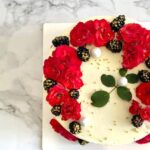When it comes to creating a visually stunning and delicious cake, the art of cake decor plays a crucial role. Learning how to make cake decor can elevate the overall look of your baked creation, turning a simple dessert into a show-stopping centerpiece. From intricate designs to simple yet elegant finishes, the possibilities are endless when it comes to decorating cakes.
Cake decor is not just about adding visual appeal; it also enhances the flavor and texture of the cake. The right decoration can complement the flavors in the cake base, bringing out its best qualities. Whether you’re decorating a birthday cake, wedding cake, or any other special occasion treat, knowing how to create beautiful and appetizing decorations is essential.
In this article, we will explore the importance of cake decor and how it can transform a plain cake into a work of art. We’ll delve into essential tools and materials needed for creating stunning decorations, tips on choosing the right cake base to complement your decor, mastering buttercream techniques, working with fondant, creative decor ideas, advanced techniques, and troubleshooting tips for achieving flawless results.
So let’s dive into the world of cake decor and unlock your creativity in making beautiful and delicious edible masterpieces.
Essential Tools and Materials
Creating stunning cake decor requires the use of essential tools and materials that can help bring your creative vision to life. One of the most important items you will need is a good set of piping bags and tips, which are essential for adding intricate designs and details to your cakes.
Piping bags come in different sizes and materials, so it’s important to choose ones that feel comfortable in your hands and can hold enough frosting or icing for your project. Additionally, having a variety of piping tips on hand will allow you to create different textures and shapes with ease.
Another crucial element in cake decor is fondant, a versatile sugar paste that can be rolled out, cut into shapes, and molded into various designs. Fondant is perfect for creating smooth finishes on cakes and adding decorative elements like flowers, ribbons, or even figurines. Make sure to have a rolling pin, fondant smoother, and sharp knife in your toolkit when working with fondant to achieve professional-looking results.
To add a touch of sparkle to your cake decor, edible glitter is a must-have item. Whether you opt for shimmer dusts, sprinkles, or edible sequins, edible glitter can elevate the overall look of your cake design by adding a hint of glamour and pizzazz. When using edible glitter, remember that less is more – a little goes a long way in creating eye-catching decorations without overwhelming the final product.
| Essential Tools | Materials |
|---|---|
| Piping bags | Fondant |
| Piping tips | Rolling pin |
| Fondant smoother | Sharp knife |
Choosing the Right Cake Base
When it comes to creating stunning cake decorations, choosing the right cake base is essential as it can truly elevate the overall look of your creation. The cake base serves as the foundation for your decor, so selecting one that complements the design elements is crucial. Here are some tips on how to choose the perfect cake base that will work harmoniously with your decorations:
- Consider the flavor: Think about what flavors will pair well with your chosen decor. For example, a rich chocolate cake might be the perfect canvas for vibrant and colorful floral decorations, while a light vanilla sponge could enhance delicate and intricate designs.
- Texture matters: The texture of your cake can also impact how well the decor adheres and looks on the final product. A moist and tender cake might be more forgiving when it comes to intricate fondant decorations, while a denser cake could provide stability for heavier decorations.
- Size and shape: The size and shape of your cake base should also be taken into consideration. Different shapes can lend themselves to different types of decorations – a round cake might be ideal for floral arrangements, while a square or rectangular cake could be great for geometric designs.
Ultimately, the goal is to select a cake base that enhances your chosen decor rather than competing with it. By paying attention to factors like flavor, texture, size, and shape, you can create a cohesive and visually pleasing final product that will impress your guests. Now that you have selected the perfect cake base, you are ready to move on to creating beautiful decor to adorn it.
Mastering Buttercream Techniques
Buttercream is a versatile and popular choice for cake decor due to its smooth texture and ability to hold intricate designs. Mastering buttercream techniques can elevate the look of your cakes and make them stand out at any occasion. Here’s a step-by-step guide on how to achieve smooth buttercream finishes and create beautiful designs using buttercream.
Preparing Your Buttercream
To start, ensure that your buttercream is at the right consistency. If it’s too stiff, you won’t be able to achieve a smooth finish, and if it’s too soft, your designs may not hold up well. Adjust the consistency by adding small amounts of powdered sugar to thicken or milk to thin it out. Make sure your buttercream is free of air bubbles by stirring it gently with a spatula.
Crumb Coat and Chill
Before applying your final layer of buttercream, it’s essential to crumb coat your cake. A crumb coat is a thin layer of frosting that locks in any loose crumbs and creates a smooth base for the rest of your decorations. Once you’ve applied the crumb coat, chill the cake in the refrigerator for about 30 minutes to set the frosting.
Piping Techniques
There are endless possibilities when it comes to piping designs with buttercream. Use different piping tips like round tips for dots, star tips for rosettes, or petal tips for floral patterns. Practice piping on a plate or parchment paper before decorating your cake to get a feel for how the frosting comes out of the bag. Experiment with different pressure levels and angles to create unique textures and designs on your cake.
Mastering buttercream techniques requires practice and patience, but the results are well worth it. With these step-by-step instructions, you’ll be able to achieve professional-looking cake decor that will impress your friends and family at any event. Experiment with different colors, flavors, and design styles to create show-stopping cakes that are as delicious as they are beautiful.
Working With Fondant
Fondant is a versatile cake decorating medium that allows for endless creative possibilities. To achieve professional-looking cake decor with fondant, it is essential to master the techniques of rolling, cutting, shaping, and troubleshooting common issues.
When working with fondant, start by kneading it to make it pliable and smooth. This will help prevent cracking and tearing when rolling it out. Use a clean, smooth work surface dusted with powdered sugar or cornstarch to prevent sticking. Roll out the fondant using a rolling pin until it is about 1/4 inch thick, ensuring it is large enough to cover the entire cake.
Cutting fondant into desired shapes requires sharp tools such as a pizza cutter, knife, or cookie cutters. For intricate designs, use small fondant cutters or craft knives for precision. Shaping fondant can be done by hand or using molds and formers to create three-dimensional elements like flowers, bows, or figures.
Troubleshooting common issues with fondant, such as air bubbles, cracks, or elephant skin texture, can be addressed by gently smoothing out the surface with your hands or a fondant smoother tool. To avoid drying out and cracking, keep unused fondant covered in plastic wrap or an airtight container when not in use.
By mastering these techniques for working with fondant, you can create beautifully decorated cakes that are sure to impress your guests. Experiment with different colors and textures to let your creativity shine through in your cake decor designs.
Creative Decor Ideas
Cake decorating is a form of art that allows bakers to unleash their creativity and add a touch of personality to their creations. When it comes to creating stunning cake decor, the possibilities are endless. One popular style that never fails to impress is floral decor.
Flowers can be made out of buttercream, fondant, or even real flowers for an elegant and romantic touch. Geometric designs, on the other hand, offer a contemporary and modern look that is perfect for special occasions like weddings or birthdays.
Abstract cake decor styles are another creative option for those looking to step outside the traditional box. Abstract designs allow bakers to play with colors, shapes, and textures to create unique and eye-catching cakes that are sure to wow guests. Whether it’s bold brush strokes, splatter patterns, or geometric shapes, abstract decor can add a fun and whimsical element to any cake.
For those looking for a more personalized touch, customizing cake decor based on a theme or event can also be a great way to make your creation stand out. Whether it’s incorporating elements like favorite colors, hobbies, or symbols into the design, personalized cake decor adds a special touch that will be appreciated by both the baker and the recipient.
No matter what style you choose, experimenting with different techniques and materials is key to creating beautiful cake decor that will leave a lasting impression on everyone who sees it. With practice and patience, mastering the art of cake decorating is achievable for anyone willing to put in the effort.
Advanced Techniques
Painting With Edible Colors
One advanced technique in cake decorating is painting with edible colors. This versatile method allows decorators to add intricate details and designs to their cakes, turning them into edible works of art. To paint with edible colors, you will need food-safe paint brushes, gel food coloring, and a palette or small containers to mix your colors.
Start by mixing a small amount of gel food coloring with clear alcohol, such as vodka or lemon extract, to create a paint-like consistency. Then, use your food-safe paint brushes to apply the colored mixture onto your cake, creating beautiful and unique designs.
Using Edible Prints
Another advanced cake decorating technique is using edible prints to add personalized touches to your cakes. You can either create your own designs or print images on edible paper using edible ink and a printer specifically made for food items.
Once you have your printed images, carefully place them on your cake surface using water or piping gel as adhesives. This technique allows you to easily incorporate intricate patterns, logos, or photos onto your cakes, making them truly one-of-a-kind.
Creating Intricate Sugar Flowers
For those looking to take their cake decor skills to the next level, creating intricate sugar flowers is an artful technique that can elevate any cake design. Use gum paste or fondant mixed with tylose powder to create a pliable yet sturdy material for sculpting delicate petals and leaves.
With the help of flower cutters and shaping tools, mold each component of the flower before assembling them together to form a beautiful blossoming creation. Whether it’s a simple rose or an elaborate peony bouquet, mastering the skill of crafting sugar flowers will surely impress anyone who sees your masterpiece.
Troubleshooting Tips
Creating beautiful cake decor can truly elevate the overall look of a cake and make it a show-stopping centerpiece for any celebration. However, like any form of art, there are common mistakes that can arise during the process. Knowing how to identify and rectify these issues is crucial in achieving a flawless final product.
One of the most common mistakes when making cake decor is creating air bubbles in the icing or fondant. To avoid this, be sure to smooth out your buttercream or fondant thoroughly and use a pin to release any trapped air bubbles. If air bubbles still appear after decorating, gently poke them with a needle and smooth out the area again for a seamless finish.
Another frequent mishap is color inconsistency in the icing or fondant. To ensure uniform color throughout your decor, remember to measure your food coloring accurately and mix it well into the icing or fondant. If you end up with streaky colors, consider kneading more deeply for better incorporation or adding a small amount of white food coloring to balance out any discrepancies.
Lastly, an issue many encounter is cracks forming in their fondant decorations. This can happen due to improper handling or insufficient kneading. To prevent cracks, make sure your fondant is rolled out evenly and smoothly without any creases before applying it to the cake. If cracks do appear after decorating, lightly rub some vegetable shortening on them and gently massage the area to blend and repair the damage seamlessly.
In conclusion, understanding these common mistakes and learning how to troubleshoot them will help you create stunning cake decor with ease. By mastering essential techniques, experimenting with creative ideas, and being prepared for unexpected challenges along the way, you’ll be able to achieve professional-looking results every time you decorate a cake. Remember, practice makes perfect when it comes to honing your skills on how to make cake decor.
Frequently Asked Questions
What Do You Need to Make Cake Decorations?
To make cake decorations, you will need various tools and supplies such as piping bags, piping tips, offset spatula, fondant or gum paste, edible food coloring, edible glitter or sprinkles, and a turntable to easily rotate the cake while decorating.
How to Make a Cake Good for Decorating?
Making a cake good for decorating starts with choosing the right type of cake. A sturdy cake like a pound cake or sponge cake works best as it can hold up well to frosting and decorations. It’s also important to ensure that the cake is completely cooled before decorating to prevent the frosting from melting.
What Are the 5 Kinds of Cake Decorating?
The five kinds of cake decorating include piping techniques where buttercream or royal icing is piped onto the cake using different tips to create designs, fondant decorations which involve rolling out fondant and using molds or cutters to create shapes, gum paste flowers where edible flower decorations are handcrafted using gum paste, edible image printing where images are printed on edible paper and placed on the cake, and airbrushing which involves spraying food coloring onto the cake for a smooth finish.

Welcome to my blog about home and family. This blog is a place where I will share my thoughts, ideas, and experiences related to these important topics. I am a stay-at-home mom with two young children. I hope you enjoy reading it! and may find some helpful tips and ideas that will make your home and family life even better!





